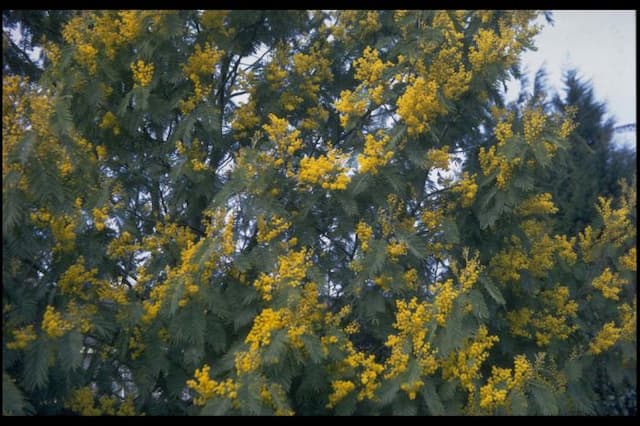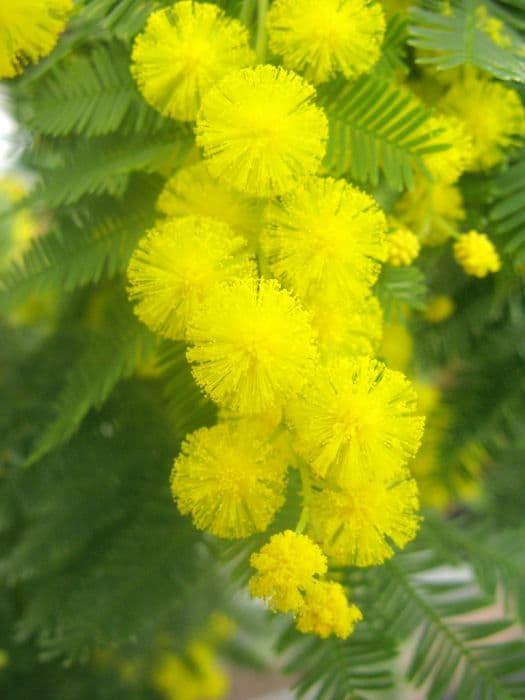Summer Chocolate Mimosa Albizia julibrissin 'Summer Chocolate' (PBR)

ABOUT
The 'Summer Chocolate' mimosa tree is a distinctive plant known for its unique foliage and stunning floral display. It features fine, feathery foliage with leaves that are a deep purple or burgundy color, offering a striking contrast to other garden plants. The texture of the leaves is light and airy, creating a delicate and lace-like appearance. During the flowering season, the 'Summer Chocolate' mimosa becomes even more impressive with its fluffy, pink, pom-pom-like flowers. These blossom clusters are fragrant and attract a variety of pollinators, including bees and butterflies. The blooms emerge from the summer into early fall, adding an extended period of visual interest. Overall, the combination of the luxurious, chocolate-toned foliage with the soft, pink flowers makes the 'Summer Chocolate' mimosa a standout specimen in any landscape. It is cherished not only for its aesthetic appeal but also for the gentle rustling sound of its leaves, which can create a soothing atmosphere in the garden.
About this plant
 Names
NamesSynonyms
Summer Chocolate Mimosa, Summer Chocolate Silk Tree, Purple-leaf Mimosa, Chocolate Mimosa, Persian Silk Tree.
Common names
Albizia julibrissin 'Summer Chocolate' (PBR).
 Toxicity
ToxicityTo humans
The plant commonly known as the silk tree or mimosa tree is not typically considered toxic to humans. However, as with many plants, it is always best to exercise caution and avoid ingesting parts of plants that are not meant for consumption, since individual sensitivities can vary.
To pets
For pets, the silk tree or mimosa tree is also not commonly listed as toxic. Yet, it is always advisable to prevent pets from eating plants, as they may have sensitivities or allergic reactions to certain species or specific parts of a plant. If a pet does ingest part of a silk tree and shows signs of illness, consult a veterinarian.
 Characteristics
CharacteristicsLife cycle
Perennials
Foliage type
Deciduous
Color of leaves
Purple
Flower color
Pink
Height
20 feet (6 meters)
Spread
15 feet (4.5 meters)
Plant type
Tree
Hardiness zones
6
Native area
Asia
Benefits
 General Benefits
General Benefits- Aesthetic Appeal: Its striking reddish-brown to deep bronze-purple foliage and fluffy, pink, powder-puff-like flowers add unique color contrast to landscaping.
- Shade Provider: The broad canopy offers a cooling shade, making it ideal for use in gardens and parks.
- Ornamental Foliage: The fern-like leaves and their changing hues through the seasons provide visual interest year-round.
- Attracts Wildlife: Flowers are a nectar source for bees and butterflies, contributing to local biodiversity.
- Focal Point Plant: Makes an excellent specimen plant due to its distinctive color and form.
- Drought Resistance: Once established, it has a degree of tolerance to periods of low water availability.
- Fast Growth: It is a rapid grower, quickly establishing itself and providing landscape impact.
- Durability: Its adaptability to a range of soils and resistance to pests make it a resilient choice for gardens.
- Multi-Season Interest: Offers visual interest from spring through autumn with its changing foliage and floral display.
 Medical Properties
Medical Properties- Sedative effects: Parts of the mimosa plant, from which Albizia julibrissin 'Summer Chocolate' derives, have been used in traditional medicine for their calming and soothing properties.
- Anxiolytic properties: Extracts from the plant have been traditionally used to help reduce anxiety.
- Antidepressant potential: Some research on the Albizia genus suggests potential antidepressant effects, though this use requires more scientific investigation.
- Anti-inflammatory: The plant may possess anti-inflammatory qualities useful in treating various conditions involving inflammation.
 Air-purifying Qualities
Air-purifying QualitiesThis plant is not specifically known for air purifying qualities.
 Other Uses
Other Uses- Photographic subject: The unique aesthetics of the Mimosa's deep purple foliage and fluffy pink flowers make it a favorite among photographers, especially when capturing the play of light and shadow on its leaves.
- Artistic inspiration: Artists often draw inspiration from the unusual coloration of Summer Chocolate Mimosa for color palettes or as a subject for botanical illustrations.
- Educational tool: Botany and horticulture teachers use the Mimosa as an example to explain the genetic mutations that lead to unusual leaf pigmentation in plants.
- Focal point in garden design: Landscape designers incorporate this plant into gardens to create a striking contrast with its rich foliage amidst varying shades of green.
- Natural dye: The bark and leaves, due to their color, could potentially be used to produce natural dyes for fabric or art materials.
- Craft material: Dried branches of Summer Chocolate Mimosa can be used for making wreaths or other crafted items, putting its distinct color and form to artistic use.
- Feng Shui element: In the practice of Feng Shui, the Summer Chocolate Mimosa's unique appearance may be utilized to balance garden spaces and invite positive energy.
- Theme gardens: This plant can be a central feature in theme gardens, such as all-season interest gardens or chocolate-themed plant collections.
- Backdrop for social events: Due to its beauty, the Mimosa tree can serve as a natural backdrop for weddings, garden parties, or other outdoor events.
- Urban green space enhancement: By incorporating such distinctive trees, urban planners can enrich the biodiversity and visual appeal of parks and green belts within cities.
Interesting Facts
 Feng Shui
Feng ShuiThe Mimosa tree is not used in Feng Shui practice.
 Zodiac Sign Compitability
Zodiac Sign CompitabilityThe Mimosa tree is not used in astrology practice.
 Plant Symbolism
Plant Symbolism- Happiness: Albizia julibrissin, commonly known as the Mimosa or Silk Tree, has fluffy, thread-like flowers that have been associated with happiness due to their delicate and cheerful appearance.
- Peace: The Mimosa's serene presence and the gentle way its leaves close during dusk and re-open at dawn symbolize peace and tranquility.
- Healing: In traditional medicine, parts of the Mimosa tree have been used to alleviate irritation and swelling, representing healing and comfort.
- Friendship: Due to its inviting and bright presence, the Mimosa is often seen as a symbol of friendship and camaraderie, with its branches reaching out much like an embrace.
- Sensitivity: The sensitive nature of the leaflets, which fold up when touched and at nightfall, can signify sensitivity and responsiveness to one's environment.
 Water
WaterThe Summer Chocolate Mimosa should be watered thoroughly, ensuring that the root zone is moistened. During the first growing season, establish a regular watering schedule to help the root system get well established; watering it once a week is advisable. Adjust the frequency depending on weather conditions; more often during hot, dry periods and less during cool, rainy periods. Generally, provide about 1 to 1.5 inches of water each week, either from rainfall or supplemented by irrigation. To avoid water waste and ensure deep water penetration, slow and deep watering methods are preferred over frequent light applications.
 Light
LightSummer Chocolate Mimosa thrives in conditions where it can receive full sun to partial shade. The ideal spot for this plant is one that enjoys unfiltered sunlight for at least six hours per day. While it tolerates light shade, too little light can lead to fewer leaflets and less vibrant foliage coloration.
 Temperature
TemperatureThe Summer Chocolate Mimosa can withstand temperatures as low as 10°F but is happiest in warmer zones where winter temperatures do not drop below 20°F. Its ideal growing temperature is between 60°F and 85°F. This plant can tolerate summer heat well, but it should be protected from harsh winter winds and extreme cold snaps.
 Pruning
PruningPruning the Summer Chocolate Mimosa is important to maintain its shape and remove any damaged or diseased branches. Prune in late winter or early spring before new growth begins to give the tree a clean start for the season. Pruning can also be done to encourage a strong structure and prevent potential damage from heavy winds or snow in colder regions. Remove no more than one fourth of the tree's total branches each year to avoid stressing the tree.
 Cleaning
CleaningAs needed
 Soil
SoilThe best soil mix for the Summer Chocolate Mimosa tree should be well-draining and loamy with some organic matter such as compost or peat moss mixed in. It prefers a slightly acidic to neutral pH ranging from 6.0 to 7.5. Ensure the soil is fertile but not waterlogged to promote healthy growth.
 Repotting
RepottingThe Summer Chocolate Mimosa tree, being larger in size, is typically planted in the ground. If grown in a container, repotting may be necessary every 2 to 3 years to provide sufficient space for root growth. Choose a well-draining pot slightly larger than the previous one.
 Humidity & Misting
Humidity & MistingThe Summer Chocolate Mimosa tree enjoys moderate to high humidity levels but is adaptable to various conditions. Aim for a humidity level that mimics its natural environment, yet it is quite resilient and will fare well in typical outdoor humidity ranges.
 Suitable locations
Suitable locationsIndoor
Place in bright, indirect light; ensure large space to grow.
Outdoor
Full sun, protect from harsh winds, mulch around base.
Hardiness zone
6-9 USDA
 Life cycle
Life cycleThe Summer Chocolate Mimosa Tree (Albizia julibrissin 'Summer Chocolate' (PBR)) begins its life cycle as a seed that germinates in warm, moist soil conditions, typically in spring. Seedlings start to develop a distinctive chocolate-brown foliage as they grow, and a fern-like appearance becomes evident. During its sapling stage, the tree establishes a strong root system and begins to develop its umbrella-shaped canopy, which becomes more pronounced over the years. As it matures, the Summer Chocolate Mimosa produces fragrant, pink, puffball-like flowers in the summer which attract pollinators and are followed by flat seed pods. The tree reaches maturity in several years and can produce flowers and seeds annually, contributing to its spread and longevity. Throughout its life, which can span over 20 years, it requires pruning to maintain its shape and health, and in colder climates, it may require protection during winter to survive.
 Propogation
PropogationPropogation time
Spring-Early Summer
The most popular method of propagation for Albizia julibrissin 'Summer Chocolate', commonly known as the Summer Chocolate Mimosa, is through semi-hardwood cuttings. This is often done in late summer to early fall when the current year's growth has matured slightly but is not yet fully hardened. A cutting, typically around 4 to 6 inches (about 10 to 15 cm) long, is taken with several leaves attached. The lower leaves are removed, and the cut end of the stem is dipped into a rooting hormone to enhance root development before being placed into a well-draining rooting medium such as a mixture of peat and perlite. The cuttings should be kept moist and in a warm environment with indirect sunlight until roots develop, which may take several weeks. Once rooted, the cuttings can be gradually acclimatized to outdoor conditions before being planted in their permanent locations.









